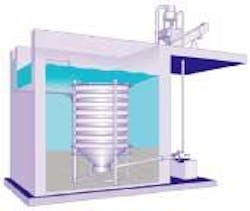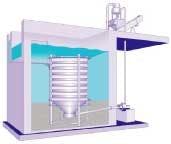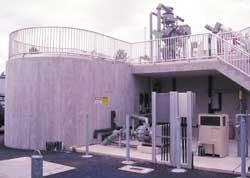Settleable Solids Concentrator Aids Plant Performance
Historically, headworks grit removal has been a common practice for eliminating deposits in pipelines, channels, tanks and anaerobic digesters. Most wastewater treatment plants have been content achieving basic plant protection with conventional grit removal systems. Many plants, however, are beginning to see the economic benefit of preventive solutions over corrective measures.
The new Headcell™ Settleable Solids Concentrator by EutekRegistered Systems™ provides plant protection and reduces costs associated with abrasion and sedimentation. In an evolving environmental landscape that emphasizes highly efficient solutions, this technology offers a non-mechanical alternative to conventional grit removal equipment.
The Headcell design outperforms conventional grit removal systems by effectively multiplying the surface area of a given chamber. Influent flow of screened sewage is evenly distributed tangentially to a nested stack of trays, and grit settles toward an underflow collection chamber while degritted water exits via an effluent channel. Grit is removed by using a large surface area and short settling distances. The concentrated solids are then pumped to a solids classifier for separation from water and organics and dewatering prior to landfill.
The concentrator system comes with a stainless steel modular tray support structure and is configured for installation in a concrete or stainless steel tank. In new headworks grit control systems, it can be installed in a poured-in-place concrete basin at grade, often with a footprint smaller than conventional systems. The modular design also allows selected components to fit into existing grit chambers, vortex grit systems or equalization basins with minimal modifications to the existing structures.
Screening is required prior to the Headcell in the process stream. Acceptable screen openings are 3/4 inch with 1/4 inch being recommended. The system can be operated in a start-stop scheme or continuous flow as necessary. The all-hydraulic design has no internal moving parts to maintain and no requirements for electrical or mechanical components within the unit to meet the specified concentration and performance.
The collected solids in the bottom of the collection chamber can be pumped to a Teacup™ or Slurrycup™ for separation and classification and discharged into a Grit Snail™ for dewatering.
Headcell applications include wastewater treatment, headworks grit removal and surface water pretreatment. Designs are available for 95 percent removal of 200-mesh, 140-mesh, 100-mesh and 70-mesh material, depending on native grit characteristics. With headloss of 12 inches at peak design flow, capacity of the largest single units can be as high as 46 mgd.
When combined with a Slurrycup and Grit Snail grit washing system, the Headcell can remove up to 95 percent of the total grit load and discharge clean grit with less than 20 percent organic solids and at least 60 percent total solids.
Important design and application considerations for choosing grit removal equipment include headloss requirements, space requirements, characteristics of the native grit and resulting targeted removal efficiency, organic content, and life-cycle costs. Plant grit load should be investigated to quantify the impacts of sugar sand or light grit.


